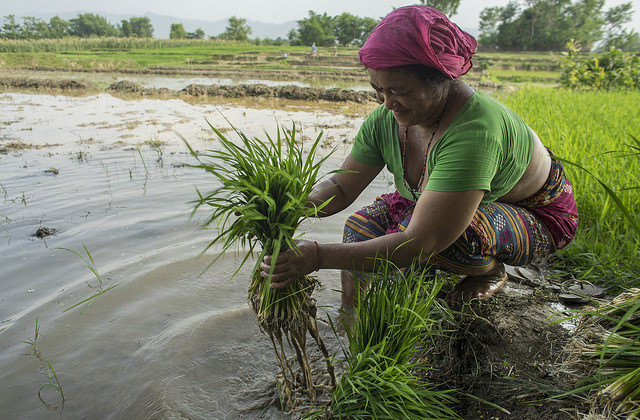
El BATAN, Mexico (CIMMYT) — Wheat, rice, maize, pearl millet, and sorghum provide over half of the world’s food calories. To maintain global food security under climate change, there is an increasing need to exploit existing genetic variability and develop crops with superior genetic yield potential and stress adaptation.
Climate change impacts food production by increasing heat and water stress among other environmental challenges, including the spread of pests, according to a recent study published by researchers at the International Maize and Wheat Improvement Center (CIMMYT). If nothing is done to currently improve the crops we grow, wheat, maize and rice are predicted to decrease in both tropical and temperate regions. Wheat yields are already slowing in most areas, with models predicting a six percent decline in yield for every 1 degree Celsius increase in global temperature.
While breeding efforts in the past have traditionally focused on increasing yield rather than survival under stresses, researchers are now working to use existing genetic diversity to create varieties that can withstand extreme weather events with yield stability in both “good” and “bad” years to better prepare our global food system for future climate variability.
The study “An integrated approach to maintaining cereal productivity under climate change” concludes the opportunity to share knowledge between crops and identify priority traits for future research can be exploited to increase breeding impacts and assist in identifying the genetic loci that control adaptation. The researchers also emphasize a more internationally coordinated approach to crop phenotyping and modeling, combined with effective sharing of knowledge, facilities, and data, will boost the cost effectiveness and facilitate genetic gains of all staple crops.
Learn more about this study and other recent publications from CIMMYT scientists, below.
- Africa’s changing farm size distribution patterns: the rise of medium-scale farms. Jayne, T.S.; Chamberlin, J.; Traub, L.; Sitko, N.J.; Muyanga, M.; Yeboah, K.; Anseeuw, W.; Chapoto, A.; Ayala Wineman; Nkonde, C.; Kachule, R. Agricultural Economics 47 (Supple.): 197-214.
- An integrated approach to maintaining cereal productivity under climate change. Reynolds, M.P.; Quilligan, E.; Bansal, K.C.; Cavalieri, A.J.; Chapman, S.; Chapotin, S.M.; Datta, S.K.; Duveiller, E.; Gill, K.S.; Jagadish, K.S.V.; Joshi, A.K.; Koehler, A.K.; Kosina, P.; Krishnan, S.; Lafitte, R.; Mahala, R.S.; Muthurajan, R.; Paterson, A.H.; Prasanna, B.M.; Rakshit, S.; Rosegrant, M.W.; Sharma, I.; Singh, R.P.; Sivasankar, S.; Vadez, V.; Valluru, R.; Prasad, V.P.V.; Yadav, O.P.; Aggarwal, P.K. Global Food Security 9 : 9-18.
- Application of unmanned aerial systems for high throughput phenotyping of large wheat breeding nurseries. Haghighattalab, A.; Gonzalez-Perez, L. Mondal, S.; Singh, D.; Schinstock, D.; Rutkoski, J.; Ortiz-Monasterio, I.; Singh, R.P.; Goodin, D.; Poland, J. Plant Methods 12: 35.
- Effect of traditional and extrusion nixtamalization on carotenoid retention in tortillas made from provitamin A biofortified maize (Zea mays L.). 2016. Rosales-Nolasco, A.; Agama-Acevedo, E.; Bello-Pérez, L.A.; Gutiérrez-Dorado, R.; Palacios-Rojas, N. Journal of Agricultural and Food Chemistry 64 (44): 8229-8295.
- Grain yield, adaptation and progress in breeding for early-maturingand heat-tolerant wheat lines in South Asia. Mondal, S.; Singh, R.P. Mason, E.R.; Huerta-Espino, J.; Autrique, E.; Joshi, A.K. Field Crops Research 192: 78-85.
- The marketing of specialty corns in Mexico: current conditions and prospects. López-Torres, J.; Rendon-Medel, R.; Camacho Villa, T.C. Revista Mexicana de Ciencias Agricolas 15: 3075-3088.
- Mining centuries old In situ conserved turkish wheat landraces for grain yield and stripe rust resistance genes. Sehgal, D.; Dreisigacker, S.; Belen, S.; Kucukozdemir, U.; Mert, Z.; Ozer, E.; Morgounov, A.I. Frontiers in Geenetics 7 : 201.
- Molecular characterisation of novel LMW-m and LMW-s genes from four Aegilops species (Sitopsis section) and comparison with those from the Glu-B3 locus of common wheat. Cuesta, S.; Guzman, C.; Alvarez, J.B. Crop and Pasture Science 67: 938-947.
- Relay intercropping and mineral fertilizer effects on biomass production, maize productivity and weed dynamics in contrasting soils under conservation agriculture. Mhlanga, B.; Cheesman, S.; Maasdorp, B.; Mupangwa, W.; Thierfelder, C. Journal of Agricultural Science. Online First.
- The evolution of the MasAgro hubs: responsiveness and serendipity as drivers of agricultural innovation in a dynamic and heterogeneous context. Camacho Villa, T.C.; Almekinders, C.; Hellin, J.; Martinez-Cruz, T.E.; Rendon-Medel, R.; Guevara-Hernández, F.; Beuchelt, T.D.; Govaerts, B. The Journal of Agricultural Education and Extension 22 (5) : 455-470.
 Climate adaptation and mitigation
Climate adaptation and mitigation 
